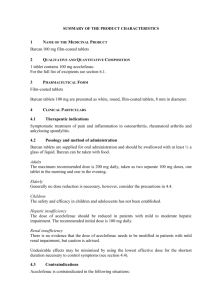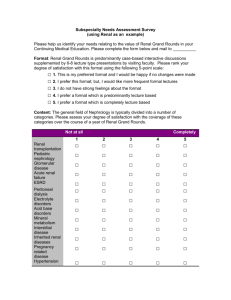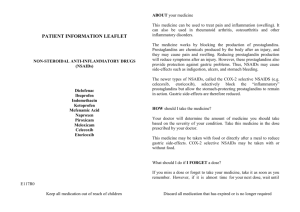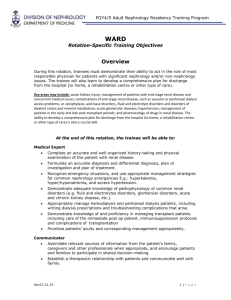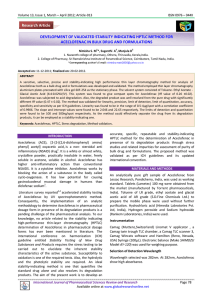Barcan film-coated tablet ENG SmPC
advertisement
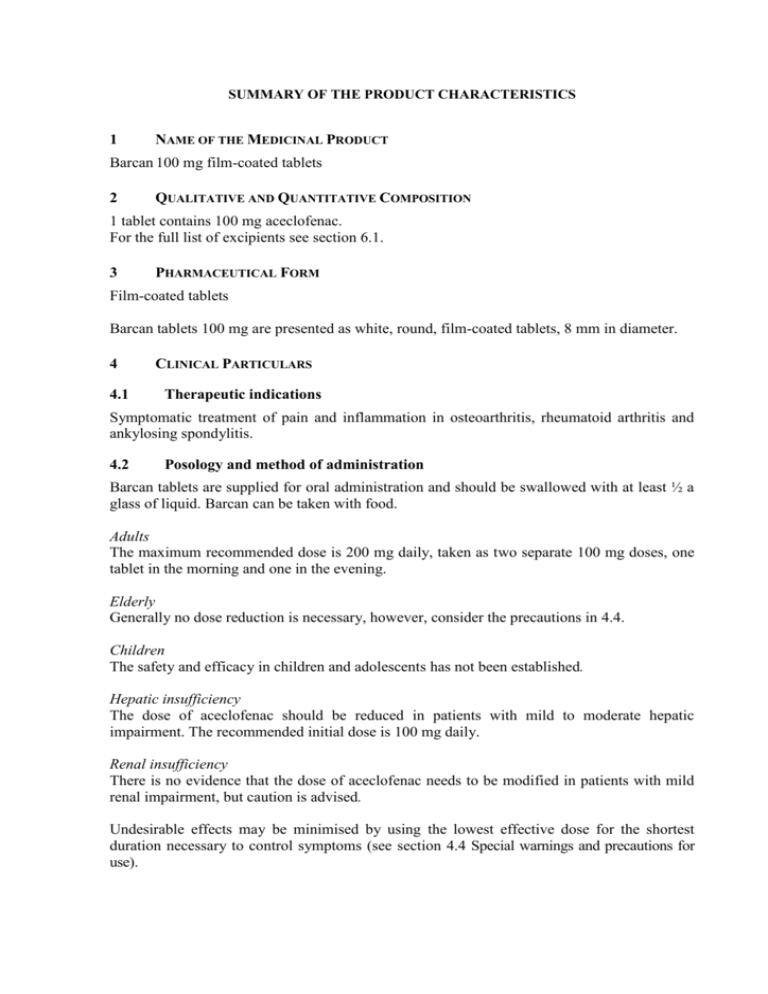
SUMMARY OF THE PRODUCT CHARACTERISTICS 1 NAME OF THE MEDICINAL PRODUCT Barcan 100 mg film-coated tablets 2 QUALITATIVE AND QUANTITATIVE COMPOSITION 1 tablet contains 100 mg aceclofenac. For the full list of excipients see section 6.1. 3 PHARMACEUTICAL FORM Film-coated tablets Barcan tablets 100 mg are presented as white, round, film-coated tablets, 8 mm in diameter. 4 4.1 CLINICAL PARTICULARS Therapeutic indications Symptomatic treatment of pain and inflammation in osteoarthritis, rheumatoid arthritis and ankylosing spondylitis. 4.2 Posology and method of administration Barcan tablets are supplied for oral administration and should be swallowed with at least ½ a glass of liquid. Barcan can be taken with food. Adults The maximum recommended dose is 200 mg daily, taken as two separate 100 mg doses, one tablet in the morning and one in the evening. Elderly Generally no dose reduction is necessary, however, consider the precautions in 4.4. Children The safety and efficacy in children and adolescents has not been established. Hepatic insufficiency The dose of aceclofenac should be reduced in patients with mild to moderate hepatic impairment. The recommended initial dose is 100 mg daily. Renal insufficiency There is no evidence that the dose of aceclofenac needs to be modified in patients with mild renal impairment, but caution is advised. Undesirable effects may be minimised by using the lowest effective dose for the shortest duration necessary to control symptoms (see section 4.4 Special warnings and precautions for use). 4.3 Contraindications Aceclofenac is contraindicated in the following situations: - patients with hypersensitivity to aceclofenac or to any of the excipients of the product listed in section 6.1 - patients in whom substances with a similar action, (e.g. aspirin, or other NSAIDs), precipitate attacks of asthma, bronchospasm, acute rhinitis or urticaria or patients hypersensitive to these drugs - patients with active bleedings or bleeding disorders - patients with a history of gastrointestinal bleeding or perforation, related to previous NSAIDs therapy - patients with active, or history of recurrent peptic ulcer/haemorrhage (two or more distinct episodes of proven ulceration or bleeding) - patients with established congestive heart failure (NYHA II-IV), ischemic heart disease, peripheral arterial disease and/or cerebrovascular disease. - patients with severely impaired hepatic or renal organfunction - during the last three months of pregnancy (see 4.6) 4.4 Special warnings and precautions for use The use of Barcan with concomitant NSAIDs including cyclooxygenase-2 selective inhibitors should be avoided. Undesirable effects may be minimised by using the lowest effective dose for the shortest duration necessary to control symptoms (see section 4.2, and GI and cardiovascular risks below). Gastrointestinal effects GI bleeding, ulceration or perforation, which can be fatal, has been reported with all NSAIDs at anytime during treatment, with or without warning symptoms or a previous history of serious GI events. The risk of GI bleeding, ulceration or perforation is higher with increasing NSAID doses, in patients with a history of ulcer, particularly if complicated with haemorrhage or perforation (see section 4.3), and in the elderly. These patients should commence treatment on the lowest dose available. Combination therapy with protective agents (e.g. misoprostol or proton pump inhibitors) should be considered for these patients, and also for patients requiring concomitant low dose aspirin, or other drugs likely to increase gastrointestinal risk (see below and 4.5). Patients with a history of GI toxicity, particularly when elderly, should report any unusual abdominal symptoms (especially GI bleeding) particularly in the initial stages of treatment. Caution should be advised in patients receiving concomitant medications which could increase the risk of ulceration or bleeding, such as systemic corticosteroids, anticoagulants such as warfarin, selective serotonin-reuptake inhibitors or anti-platelet agents such as aspirin (see section 4.5). When GI bleeding or ulceration occurs in patients receiving Barcan, the treatment should be withdrawn. NSAIDs should be given with care and under close medical surveillance to patients with symptoms indicative of gastro-intestinal disorders involving either the upper or lower gastrointestinal tract , a history suggestive of gastro-intestinal ulceration, bleeding or perforation, ulcerative colitis, Crohn’s disease and haemotological abnormalities as these conditions may be exacerbated (see section 4.8). Cardiovascular and cerebrovascular effects Appropriate monitoring and advice are required for patients with a history of hypertension and/or mild to moderate congestive heart failure as fluid retention and oedema have been reported in association with NSAID therapy. Aceclofenac should also be administered with caution and under close medical surveillance to patients with a history of cerebrovascular bleeding. Patients with congestive heart failure (NYHA–I) and patients with significant risk factors for cardiovascular events (e.g. hypertension, hyperlipidaemia, diabetes mellitus,smoking) should only be treated with aceclofenac after careful consideration. As the cardiovascular risks of aceclofenac may increase with dose and duration of exposure, the shortest duration possible and the lowest effective daily dose should be used. The patient's need for symptomatic relief and response to therapy should be re-evaluated periodically. Renal The administration of an NSAID may cause a dose dependent reduction in prostaglandin formation and precipitate renal failure. The importance of prostaglandins in maintaining renal blood flow should be taken into account in patients with impaired cardiac or renal function, liver dysfunction, those being treated with diuretics or recovering from major surgery or from other reasons being at risk for hypovolemia, and the elderly. Patients with mild to moderate impairment of renal function should be kept under surveillance, since the use of NSAIDs may result in deterioration of renal function. The lowest effective dose should be used and renal function monitored regularly. Effects on renal function are usually reversible on withdrawal of aceclofenac. Hepatic Close medical surveillance is needed in patients suffering from mild to moderate hepatic function impairment. Aceclofenac should be discontinued if abnormal liver function tests persist or worsen, clinical signs or symptoms consistent with liver disease develop or if other manifestations occur (eosinophilia, rash). Hepatitis may occur without prodromal symptoms. Use of NSAIDs in patients with hepatic porphyria may trigger an attack. Hypersensitivity and skin reactions As with other NSAIDs, allergic reactions, including anaphylactic/anaphylactoid reactions, can also occur without earlier exposure to the drug. Serious skin reactions, some of them fatal, including exfoliative dermatitis, Stevens-Johnson syndrome, and toxic epidermal necrolysis, have been reported very rarely in association with the use of NSAIDSs (see 4.8). Patients appear to be at highest risk of these reactions early in the course of therapy, the onset of the reaction occurring in the majority of cases within the first month of treatment. Barcan should be discontinued at the first appearance of skin rash, mucosal lesions, or any other sign of hypersensitivity. Exceptionally, varicella can trigger serious cutaneous and soft tissues infections complications. To date, the contributing role of NSAIDs in the worsening of these infections cannot be ruled out. Thus, it is advisable to avoid use of Barcan tablets in case of varicella. Haematological Aceclofenac may reversibly inhibit platelet aggregation (See section 4.5). Respiratory disorders Caution is required if administered to patients suffering from, or with a previous history of, bronchial asthma since NSAIDs have been reported to precipitate bronchospasm in such patients. Elderly The elderly have an increased frequency of adverse reactions to NSAIDs especially gastrointestinal bleeding and perforation which may be fatal (see section 4.2). The gastrointestinal bleeding and/or perforation, are often more serious and may occur without warning symptoms or previous history, at any time during treatment. Furthermore, elderly patients are more likely to be suffering from impaired renal, cardiovascular or hepatic function. Long-term treatment All patients who are receiving long-term treatment with NSAIDs should be monitored as a precautionary measure (e.g. renal, hepatic function and blood counts). Aceclofenac should be administered with caution and under close medical surveillance to patients with a history of SLE, porphyria, or hematopoietic disorders Fertility The use of Barcan may impair fertility, see section 4.6. 4.5 Interaction with other medicinal products and other forms of interaction No pharmacokinetic interaction studies have been performed, except with warfarin. Aceclofenac is metabolized through cytochrome P450 2C9 and in vitro data indicate that aceclofenac may be an inhibitor of this enzyme. A risk of pharmacokinetic interaction is therefore possible with phenytoin, cimetidine, tolbutamide, phenylbutazone, amiodarone, miconazol and sulphaphenazole. As with other products within the NSAID-group, there also exists a risk of pharmacokinetic interactions with other drugs eliminated by active renal secretion, such as methotrexate and lithium. Aceclofenac is bound practically completely to plasma albumin and consequently the possibility of displacement interactions with other highly protein bound drugs must be borne in mind. Due to the lack of pharmacokinetic interaction studies the following is based upon knowledge from other NSAIDs: The following combinations should be avoided: Methotrexate (high dose): NSAIDs inhibit the tubular secretion of methotrexate and a slight metabolic interaction may also occur, resulting in decreased clearance of methotrexate. Therefore, during treatment with high dose methotrexate prescription of NSAID drugs should always be avoided. Lithium and digoxin: Several NSAID drugs inhibit the renal clearance of lithium and digoxin, resulting in increased serum concentrations of both. The combination should be avoided unless frequent monitoring of lithium and digoxin levels can be performed. Corticosteroids: increased risk of gastrointestinal ulceration or bleeding (see section 4.4) Anti-coagulants: NSAIDs,may enhance the effects of anti-coagulants, such as warfarin (see section 4.4). Close monitoring of patients on combined anticoagulant and aceclofenac therapy should be undertaken. Anti-platelet agents and selective serotonin reuptake inhibitors (SSRIs): increased risk of gastrointestinal bleeding (see section 4.4). The following combinations may require dose adjustments and precautions: Methotrexate (low dose): The possible interaction between NSAIDs and methotrexate should be born in mind also when low doses of methotrexate are used, especially in patients with decreased renal function. When combination therapy has to be used, the renal function should be monitored. Caution should be exercised if both an NSAID and methotrexate are administered within a 24-hour period, since the methotrexate levels may increase and result in increased toxicity. Cyclosporine, tacrolimus: Administration of NSAID drugs together with cyclosporine or tacrolimus is thought to increase the risk of nephrotoxicity due to decreased synthesis of prostacycline in the kidney. During combination therapy it is therefore important to carefully monitor renal function. Other NSAIDs, including salicylates (acetylsalicylic acid > 3 g/day): Concomitant therapy with aspirin and other non-steroidal anti-inflammatory drugs may increase the frequency of side effects and therefore caution is required. Antihypertensives: NSAIDs may reduce the effect of antihypertensive medicinal products. The risk of acute renal insufficiency, which is usually reversible, may be increased in some patients with compromised renal function (e.g. dehydrated patients or elderly patients) when ACEinhibitors or angiotensin II receptor antagonists are combined with NSAIDs. Therefore, the combination should be administered with caution, especially in the elderly. Patients should be adequately hydrated and consideration should be given to monitoring of renal function after initiation of concomitant therapy, and periodically thereafter. Diuretics: Aceclofenac, like other NSAIDs, may inhibit the activity of diuretics. Concomitant treatment with potassium-sparing diuretics may be associated with increased potassiumlevels, hence, serum potassium should be monitored. Aceclofenac was not found to affect blood pressure control when it was coadministered with bendrofluazide, although an interaction with other diuretics cannot be ruled out. Anti-diabetic agents: Clinical studies have shown that diclofenac can be given together with oral antidiabetic agents without influencing their clinical effect. There have been isolated reports of hypoglycaemic and hyperglycaemic effects. Thus for aceclofenac, consideration should be given to adjustment of the dosage of agents, that might produce hypoglycaemia. Zidovudine: When NSAIDs are given with zidovudine there is an increased risk of haematological toxicity. There are indications of an increased risk of haemoarthroses and haematoma in HIV(+) haemophiliacs receiving concurrent treatment with zidovudine and ibuprofen. 4.6 Fertility, pregnancy and lactation Pregnancy There is no information on the use of aceclofenac during pregnancy. Inhibition of prostaglandin synthesis may adversely affect the pregnancy and/or the embryo/foetal development. Data from epidemiological studies suggest an increased risk of miscarriage and of cardiac malformation and gastroschisis after use of a prostaglandin synthesis inhibitor in early pregnancy. The absolute risk for cardiovascular malformation was increased from less than 1%, up to approximately 1.5%. The risk is believed to increase with dose and duration of therapy. In animals, administration of a prostaglandin synthesis inhibitor has been shown to result in increased pre- and postimplantation loss and embryo-foetal lethality. In addition, increased incidences of various malformations, including cardiovascular, have been reported in animals given a prostaglandin synthesis inhibitor during the organogenetic period. During the first and second trimester of pregnancy, Barcan should not be given unless clearly necessary. If Barcan is used by a woman attempting to conceive, or during the first and second trimester of pregnancy, the dose should be kept as low and duration of treatment as short as possible. During the third trimester of pregnancy, all prostaglandin synthesis inhibitors may expose the fetus to: cardiopulmonary toxicity (with premature closure of the ductus arteriosus and pulmonary hypertension); renal dysfunction, which may progress to renal failure with oligo-hydroamniosis; The mother and the neonate, at the end of pregnancy, to: possible prolongation of bleeding time, an anti-aggregating effect which may occur even after very low doses. inhibition of uterine contractions resulting in delayed or prolonged labour. Consequently, Barcan is contraindicated during the third trimester of pregnancy (see section 4.3). Lactation It is not known whether aceclofenac is excreted in human milk. There was however no notable transfer of radio-labelled (14C) aceclofenac to the milk of lactating rats. A decision on whether to continue/discontinue breast-feeding or to continue/discontinue therapy with Barcan should be made taking into account the benefit of breast-feeding to the child and the benefit of Barcan therapy to the woman. Fertility The use of Barcan, as with any drug known to inhibit cyclo-oxygenase / prostaglandin synthesis, may impair fertility and is not recommended in women attempting to conceive. In women who have difficulty conceiving or who are undergoing investigation of infertility, withdrawal of Barcan should be considered. 4.7 Effects on ability to drive and use machines Patients who experience dizziness, vertigo, or other central nervous system disturbances while taking NSAIDs should refrain from driving or operating machinery. 4.8 Undesirable effects Gastrointestinal: The most commonly observed adverse events are gastrointestinal in nature. Peptic ulcers, perforation or GI bleeding, sometimes fatal, particularly in the elderly, may occur with NSAIDs (see section 4.4). Nausea, vomiting, diarrhoea, flatulence, constipation, dyspepsia, abdominal pain, melaena, haematemesis, ulcerative stomatitis, exacerbation of colitis and Crohn’s disease (see section 4.4) have been reported following administration of NSAIDs. Less frequently, gastritis has been observed. Oedema, hypertension and cardiac failure have been reported in association with NSAID treatment. Other very rare (<1/10000) class-effects reported with NSAIDs are: Renal and urinary disorders – Nephritis interstitial Bullous reactions including Stevens-Johnson syndrome and toxic epidermal necrolysis. Exceptionally, occurrence of serious cutaneous and soft tissues infections complications during varicella has been reported in association with NSAID treatment. The following is a list of adverse reactions reported from clinical trials and which were later corroborated in post-marketing experience or only notified during post-marketing experience, grouped by System-Organ Classes and estimated frequencies. Very common (≥1/10); common (≥1/100 to <1/10); uncommon (≥1/1,000 to <1/100), rare (≥1/10,000 to <1/1,000), very rare (<1/10,000). Rare (≥ 1/10000 to <1/1000) Very rare (<1/10000) Blood and lymphatic system disorders Anaemia Bone Marrow depression Granulocytopenia Thrombocytopenia Neutropenia Haemolytic anaemia Immune system disorders Anaphylactic reaction (including shock) Hypersensitivity MedDRa SOC Common ( Uncommon(≥1/1000to ≥ 1/100 to <1/100) <1/10) Metabolism and nutrition disorders Hyperkalemia Psychiatric disorders Depression Abnormal dreams Insomnia Paraesthesia Tremor Somnolence Headache Dysgeusia (abnormal taste) Nervous system disorders Dizziness MedDRa SOC Common ( Uncommon(≥1/1000to ≥ 1/100 to <1/100) <1/10) Eye disorders Vascular disorders Dyspepsia Abdominal pain Nausea Diarrhoea Flatulence Gastritis Constipation Vomiting Mouth ulceration Cardiac failure Vertigo Tinnitus Palpitations Hypertension Hypertension aggravated Dyspnoea Flushing Hot flush Vasculitis Bronchospasm Melaena Gastrointestinal ulceration Haemorrhagic diarrhoea Stomatitis Haematemesis Gastric ulcer Intestional perforation Exacervation of Crohn disease and Colitis Ulcerative Pancreatitis Gastrointestinal haemorrhage Hepatobiliary disorders Very rare (<1/10000) Visual disturbance Ear and labyrinth disorders Cardiac disorders Respiratory, thoracic and mediastinal disorders Gastrointestinal disorders Rare (≥ 1/10000 to <1/1000) Hepatic enzyme increased Skin and subcutaneous tissue disorders Pruritus Rash Dermatitis Urticaria Renal and urinary disorders Blood urea increased Blood creatinine increased General disorders and administration site conditions Investigations Angioedema Hepatic injury (including hepatitis) Blood alkaline phosphatase increased Purpura Eczema Severe mucocutaneous skin reactions (including Stevens Johnson Syndrome and Toxic Epidermal Necrolysis) Nephrotic syndrome Renal Failure Oedema Fatigue Cramps in legs Weight increase Aceclofenac is both structurally related and metabolised to diclofenac for which a greater amount of clinical and epidemiological data consistently point towards an increased risk of general arterial thrombotic events (myocardial infarction or stroke, particularly at high doses and in long treatment). Epidemiological data has also found an increased risk of acute coronary syndrome and myocardial infarction associated with the use of aceclofenac (see section 4.3 and 4.4 for Contraindications and Special warnings and special precautions for use). Reporting of suspected adverse reactions Reporting suspected adverse reactions after authorisation of the medicinal product is important. It allows continued monitoring of the benefit/risk balance of the medicinal product. Healthcare professionals are asked to report any suspected adverse reactions via the national reporting system listed in Appendix V. 4.9 Overdose There is insufficient data available on the consequences of aceclofenac overdose in humans. The symptoms could be: Nausea, vomiting, stomach pain, dizziness, somnolence and headache. The treatment of acute poisoning by non-steroid anti-inflammatory drugs basically consists of antacids when necessary and other supportive and symptomatic treatment for complications such as hypotension, renal failure, convulsions, gastro-intestinal irritation, and respiratory depression. Management of acute poisoning with oral aceclofenac consist of preventing absorption as soon as possible after overdose by means of gastric lavage and treatment with activated charcoal in repeated doses.Forced diuresis, dialysis or haemoperfusion may not be able to eliminate NSAIDs due to their high rate of protein binding and extensive metabolism. 5 5.1 PHARMACOLOGICAL PROPERTIES Pharmacodynamic properties Pharmacotherapeutic group: Antiinflammatory and antirheumatic products, non-steroids. ATC code: M01AB16 Aceclofenac is a non-steroidal substance with antiinflammatory and analgesic effects. Its mechanism of action is thought to be due to inhibition of prostaglandin synthesis. 5.2 Pharmacokinetic properties Absorption: After oral administration, aceclofenac is rapidly absorbed and the bioavailability is almost 100%. Peak plasma concentrations are reached approximately 1.25 to 3 hours following ingestion. Tmax is delayed with concomitant food intake whereas the degree of absorption is not influenced. Distribution: Aceclofenac is highly protein-bound (>99.7%). Aceclofenac penetrates into the synovial fluid, where the concentrations reach approximately 60% of those in plasma. The volume of distribution is approximately 30L. Elimination: The mean plasma elimination half-life is 4 – 4.3 hours. Clearance is estimated to 5 litres per hour. Approximately two-thirds of the administered dose is excreted via the urine, mainly as conjugated hydroxymetabolites. Only 1% of an oral single dose is excreted unchanged. Aceclofenac is probably metabolized via CYP2C9 to the main metabolite 4’-OH-aceclofenac whose contribution to the clinical activity probably is negligible. Diclofenac and 4’-OHdiclofenac have been detected amongst many metabolites. Characteristics in patients No changes in the pharmacokinetics of aceclofenac have been detected in the elderly. A slower rate of elimination of aceclofenac has been detected in patients with decreased liver function after a single dose of aceclofenac. In a multiple dose study using 100 mg once daily, there was no difference in the pharmacokinetic parameters between subjects with mild to moderate liver cirrhosis and normal subjects. In patients with mild to moderate renal impairment no clinically significant differences in the pharmacokinetics were observed after a single dose. 5.3 Preclinical safety data Similarly to other NSAIDs, aceclofenac is poorly tolerated by experimental animals. Additionally, pharmacokinetic differences between animals and man make it difficult to evaluate the potential toxicity of aceclofenac. The principal target organ was the gastrointestinal tract. However, toxicity studies employing maximally tolerated dosages in the rat, a species which metabolizes aceclofenac to diclofenac, and in the monkey (some exposure to unchanged aceclofenac) showed no other toxic effects than those commonly seen with NSAIDs. Animal studies indicate that there was no evidence of teratogenesis in rats although the systemic exposure was low and in rabbits, treatment with aceclofenac (10 mg/kg/day) resulted in a series of morphological changes in some foetuses Carcinogenicity studies in the mouse (systemic exposure to aceclofenac unknown) and in the rat (metabolism to diclofenac) did not show any carcinogenic effect and aceclofenac was negative in genotoxicity tests. 6 6.1 PHARMACEUTICAL PARTICULARS List of excipients 1 tablet contains: Microcrystalline cellulose Croscarmellose sodium Povidone Glyceryl palmitostearate The film coat contains: Hypromellose Microcrystalline cellulose Macrogol 40 stearate Titanium dioxide 6.2 Incompatibilities Not applicable. 6.3 Shelf-life 4 years. 6.4 Special precautions for storage Do not store above 30C. 6.5 Nature and content of container Blister package (aluminium/aluminium) containing 10, 20, 30, 50, 60, 100 and 600 (30 x 20) tablets. Each strip contains 10 or 15 tablets. Not all pack sizes may be marketed. 6.6 Special precautions for disposal and other handling No special requirements. 7 MARKETING AUTHORISATION HOLDER Almirall, S.A. General Mitre 151 08022 Barcelona Spain 8 MARKETING AUTHORISATION NUMBER < [To be completed nationally] > 9 DATE OF FIRST AUTHORISATION/RENEWAL OF THE AUTHORISATION Date of first authorisation: 20 March 1996 Date of latest renewal: 19 March 2010 < [To be completed nationally] > 10 DATE OF REVISION OF THE TEXT 2014-07-04
